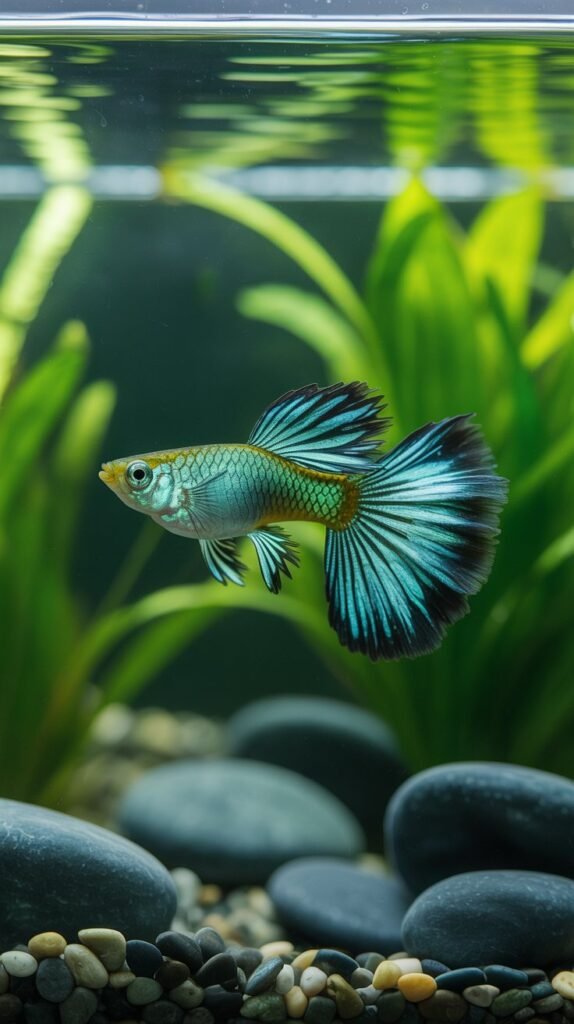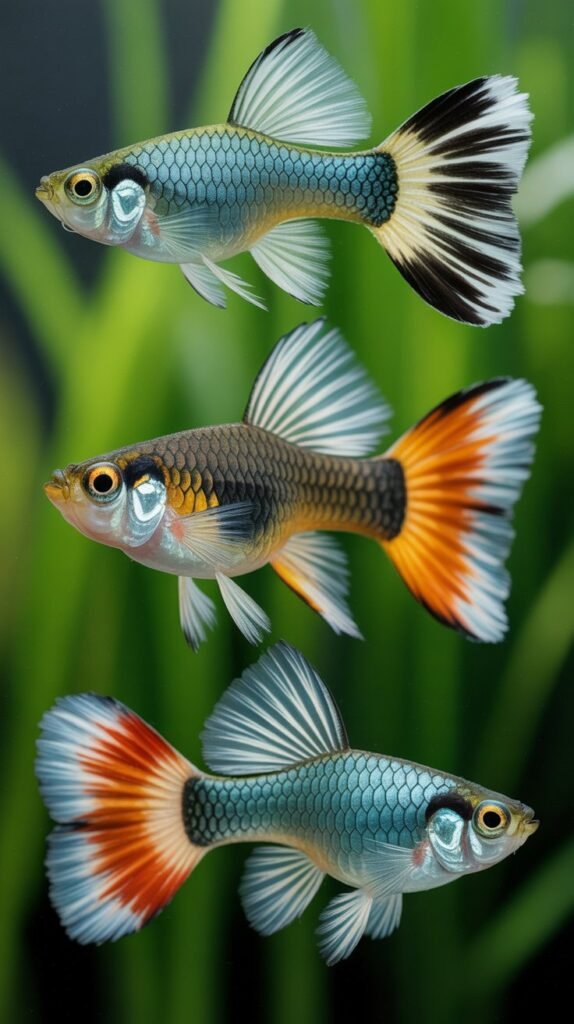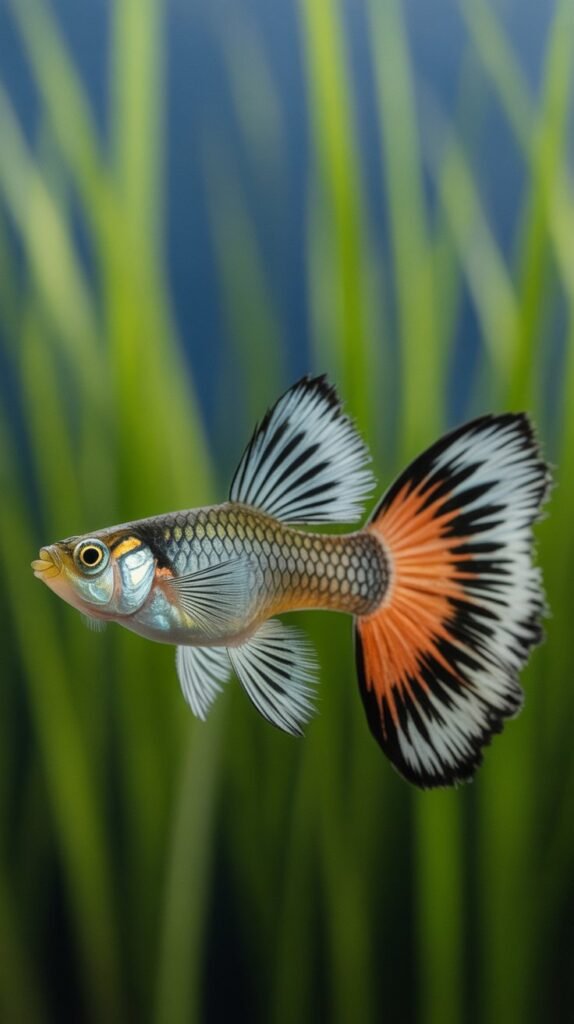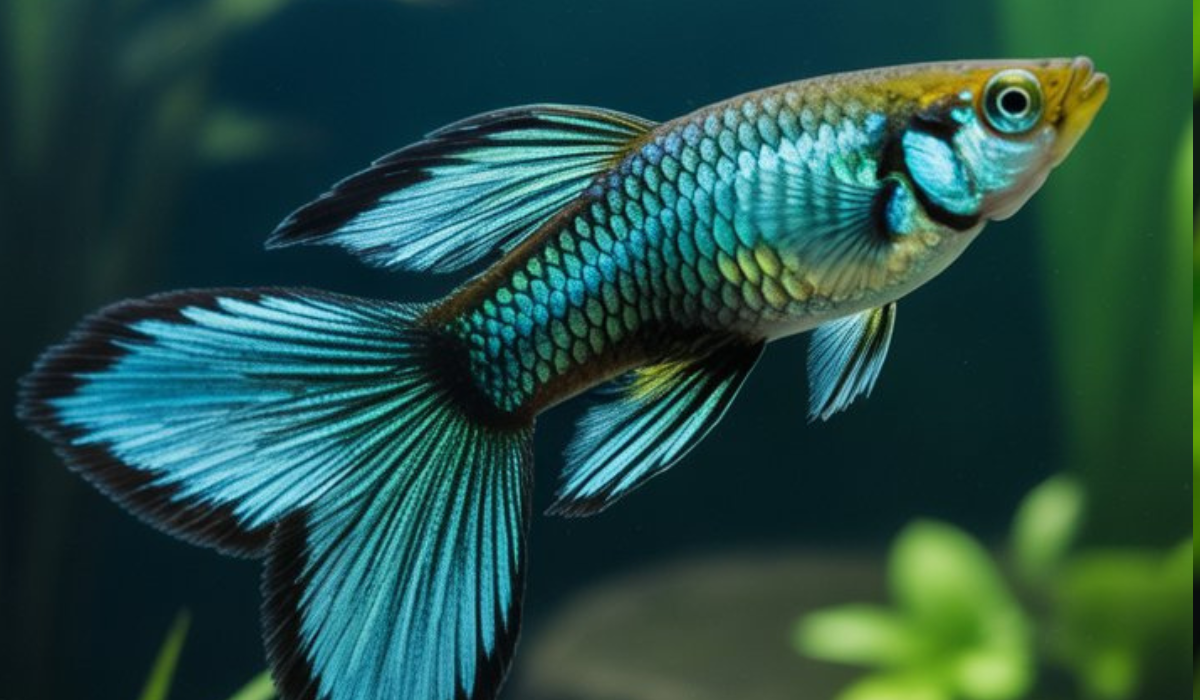If you’re looking for a guppy that combines elegance, grace, and ease of care, the Grass Tail Guppy might be exactly what you need. Known for its unique tail pattern that resembles blades of grass swaying underwater, this guppy variety is a favorite among aquarists who love natural beauty and vibrant movement in their tanks.
In this comprehensive guide, we’ll cover everything you need to know about the Grass Tail Guppy — including its appearance, origin, behavior, tank setup, breeding, diet, and more — along with answers to the most common FAQs at the end.
1. Introduction to the Grass Tail Guppy
The Grass Tail Guppy is a selectively bred guppy variety known for its fine, grass-like tail pattern. This pattern gives the tail a delicate and flowing appearance, similar to strands of underwater plants. It is one of the most refined and elegant guppy types, making it a popular choice for aquascaped tanks and decorative aquariums.
These guppies are admired for their:
- Beautiful, grass-patterned tails
- Peaceful and social behavior
- Hardiness and adaptability
- Easy breeding potential
Grass Tail Guppies come in various color variations, including green, blue, yellow, red, and albino, each more striking than the last.
2. Appearance and Coloration

The standout feature of the Grass Tail Guppy is, of course, its tail. The fine lines and flowing pattern resemble the gentle blades of grass moving in water, hence the name “Grass Tail.”
Key Characteristics:
- Tail Pattern: The caudal fin (tail) is elongated with fine streaks or lines extending from the body outward, giving it a grassy appearance.
- Body Shape: Slender and streamlined, typical of guppies.
- Color Variations: Can range from blue, green, red, yellow, to even metallic hues depending on breeding.
- Dorsal Fin: Usually large and complements the tail’s pattern.
- Size: Males are around 1.5–2 inches; females slightly larger at 2.5 inches.
Under proper lighting, their tails shimmer beautifully, creating a mesmerizing underwater display.
3. Origin and Breeding History
The Grass Tail Guppy (Poecilia reticulata) is a result of selective breeding from wild guppies originating in South America — particularly Venezuela, Guyana, and Trinidad. Over decades, aquarists selectively bred guppies to produce specific tail shapes and patterns. The Grass Tail pattern emerged as a result of breeding efforts to create a natural yet intricate tail design.
Breeders have since developed several subtypes, including:
- Green Grass Guppy
- Blue Grass Guppy
- Red Grass Guppy
- Yellow Grass Guppy
- Albino Grass Guppy
Each color morph maintains the same fine, flowing tail pattern that defines the Grass Tail strain.
4. Behavior and Temperament
Grass Tail Guppies are peaceful, active, and curious fish. They thrive in groups and are perfect for community aquariums.
Behavioral Traits:
- Very active swimmers
- Non-aggressive and social
- Prefer mid-to-upper levels of the tank
- Males often display their tails to attract females
They get along well with other peaceful species and rarely show aggression, making them suitable for mixed tanks.
5. Ideal Tank Setup for Grass Tail Guppies

Creating a perfect environment is essential for the health and coloration of your Grass Tail Guppies.
Tank Size
- Minimum: 10 gallons for a trio (1 male and 2 females)
- Recommended: 20–30 gallons for a colony or community setup
Substrate
- Fine gravel or sand substrate enhances the tank’s aesthetics and mimics their natural environment.
Plants and Decor
Grass Tail Guppies love planted tanks because they provide hiding places and a sense of security.
Recommended plants:
- Guppy Grass (Najas guadalupensis)
- Java Fern
- Hornwort
- Anubias Nana
- Water Wisteria
Add driftwood, smooth stones, and open swimming areas to create a balanced aquascape.
Lighting
- Use moderate LED lighting to enhance their colors and highlight tail patterns.
- Avoid overly bright light that causes stress.
Filtration
- A sponge filter or gentle hang-on-back filter is ideal.
- Guppies dislike strong currents, so ensure slow water movement.
Water Parameters
| Parameter | Ideal Range |
|---|---|
| Temperature | 72–82°F (22–28°C) |
| pH | 6.8–7.8 |
| Hardness | 8–12 dGH |
| Ammonia | 0 ppm |
| Nitrite | 0 ppm |
| Nitrate | < 20 ppm |
Perform 20–30% weekly water changes to keep the water clean and oxygenated.
6. Diet and Feeding
Grass Tail Guppies are omnivores and thrive on a balanced diet rich in both plant and animal matter.
Recommended Foods:
- High-quality flake food as a staple diet
- Live or frozen foods: Brine shrimp, daphnia, mosquito larvae, bloodworms
- Vegetable matter: Blanched spinach, zucchini, or spirulina flakes
- Occasional treats: Freeze-dried tubifex worms or krill
Feed small portions 2–3 times daily, ensuring they consume everything within a few minutes. Overfeeding can pollute the tank and harm water quality.
7. Tankmates for Grass Tail Guppies
Grass Tail Guppies are peaceful and compatible with most other small, non-aggressive fish.
Ideal Tankmates:
- Other guppies (same size and temperament)
- Platies, Mollies, Swordtails
- Neon Tetras, Ember Tetras, Rasboras
- Corydoras catfish
- Cherry Shrimp, Amano Shrimp, and Snails
Avoid:
- Aggressive species like Betta, Cichlids, or Barbs
- Fin-nipping fish that may damage their tails
8. Breeding Grass Tail Guppies

Breeding Grass Tail Guppies is straightforward and rewarding. They’re livebearers, meaning females give birth to fully formed fry instead of laying eggs.
Breeding Setup:
- Breeding Tank: 10–15 gallons with gentle filtration and plenty of plants.
- Ratio: 1 male to 2–3 females to reduce stress.
- Temperature: Maintain around 78°F (25°C) for optimal breeding.
Mating and Gestation:
- Males court females by displaying their tails.
- Fertilization occurs internally.
- Gestation period: 21–30 days.
- Females can produce 20–60 fry per birth.
Fry Care:
- Separate fry from adults to prevent predation.
- Feed fry with infusoria, baby brine shrimp, or crushed flakes.
- Maintain clean water and stable temperature.
Within a few weeks, fry begin to develop color and patterns, and their tails start to show the characteristic grass-like design.
9. Male vs Female Grass Tail Guppies
| Feature | Male | Female |
|---|---|---|
| Size | Smaller (1.5–2 inches) | Larger (2–2.5 inches) |
| Color | Bright and vivid | Less colorful |
| Fins | Longer, flowy tail | Shorter fins |
| Body Shape | Slim, streamlined | Rounded belly |
| Gravid Spot | Absent | Visible near anal fin |
| Behavior | Active, display fins | Calm and passive |
Males are more colorful and spend most of their time courting females, while females play a crucial role in fry production.
10. Common Diseases and Health Issues
Grass Tail Guppies are hardy, but poor water conditions or stress can lead to disease.
Common Diseases:
- Ich (White Spot Disease): White spots on fins and body.
- Treatment: Raise temperature to 82°F and add aquarium salt or Ich medication.
- Fin Rot: Fraying or decaying fins due to bacteria.
- Treatment: Improve water quality and use antibacterial treatments.
- Velvet Disease: Gold-dust-like coating on body and fins.
- Treatment: Quarantine affected fish and treat with copper-based medications.
- Swim Bladder Disorder: Difficulty swimming or floating sideways.
- Treatment: Feed high-fiber foods and maintain clean water.
Prevention Tips:
- Maintain water quality.
- Avoid overcrowding.
- Quarantine new fish before introducing them.
- Feed a varied, nutritious diet.
11. How to Enhance the Colors of Grass Tail Guppies
Vibrant colors are a sign of good health. Here’s how to make your Grass Tail Guppies even more beautiful:
- Provide a Balanced Diet: Include live foods for natural pigments.
- Good Lighting: Proper aquarium lighting enhances metallic hues.
- Clean Water: Stable water conditions prevent color fading.
- Dark Backgrounds: Dark substrates and backdrops intensify color contrast.
- Reduce Stress: Keep tankmates peaceful and maintain consistency in care.
12. Lifespan and Growth
With proper care, Grass Tail Guppies live around 2–3 years, though some may reach up to 4 years in optimal conditions.
They grow rapidly within the first few months, reaching sexual maturity at about 3 months of age. During this time, it’s important to provide them with protein-rich food for healthy development and tail formation.
13. Price and Availability
Grass Tail Guppies are popular and widely available both online and in aquarium stores.
- Price Range: $3–$10 per fish, depending on color quality and size.
- Pairs or Trios: Often sold as 1 male + 2 females.
- Rare Varieties: Albino or metallic versions may cost more.
Since they breed quickly, many aquarists start small and build large colonies over time.
14. Tips for Successful Care
- Keep Water Stable: Avoid sudden temperature or pH changes.
- Regular Maintenance: Weekly 25% water changes are ideal.
- Avoid Overcrowding: Follow the 1 inch of fish per gallon rule.
- Use Live Plants: They help maintain water quality and reduce stress.
- Monitor Health: Watch for fin damage or lethargy as early warning signs.
Consistent care ensures your Grass Tail Guppies remain healthy and vibrant throughout their lives.
15. Why Choose Grass Tail Guppies?
Here’s why aquarists love this particular guppy variety:
- Graceful and mesmerizing tail pattern
- Hardy and beginner-friendly
- Peaceful community fish
- Easy to breed and maintain
- Available in a wide range of colors
Whether you’re a beginner or a seasoned fish keeper, Grass Tail Guppies bring natural elegance, color, and vitality to your aquarium.
16. Conclusion
The Grass Tail Guppy is a perfect blend of beauty, activity, and simplicity. With its signature grass-like tail, vibrant colors, and easygoing nature, it’s no wonder that this guppy strain has become a favorite among aquarists worldwide.
Providing the right care — clean water, balanced diet, and a peaceful environment — will ensure your guppies remain healthy and colorful for years to come. Plus, their simple breeding habits make them an excellent choice for hobbyists who want to grow their guppy collection naturally.
If you’re looking for a fish that’s elegant, hardy, and endlessly fascinating, the Grass Tail Guppy is a must-have addition to your tank.
FAQs About Grass Tail Guppies
1. What makes Grass Tail Guppies unique?
Their tail pattern resembles blades of grass, giving them a flowing and elegant appearance unlike any other guppy strain.
2. Are Grass Tail Guppies beginner-friendly?
Yes, they’re hardy, peaceful, and easy to care for — ideal for beginners.
3. What is the ideal water temperature for Grass Tail Guppies?
Keep them between 72°F and 82°F (22–28°C) for best results.
4. Can Grass Tail Guppies live with other fish?
Absolutely. They get along with peaceful species like tetras, mollies, and shrimp.
5. How often should I feed Grass Tail Guppies?
Feed them small portions 2–3 times daily with a balanced diet of flakes, live, and plant-based foods.
6. How long do Grass Tail Guppies live?
They live 2–3 years on average, with proper care extending their lifespan.
7. How can I tell males and females apart?
Males are smaller, more colorful, and have longer tails, while females are larger and less vibrant.
8. Do Grass Tail Guppies need a filter?
Yes, a gentle filter helps maintain water quality and oxygenation.
9. Can Grass Tail Guppies breed easily?
Yes, they are livebearers and breed readily, often giving birth every 3–4 weeks.
10. Where can I buy Grass Tail Guppies?
They are available in most pet stores, aquarium shops, and online fish retailers.

